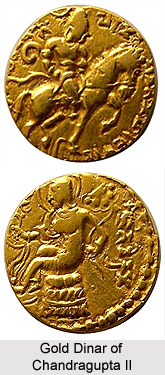 The Guptas had ruled north India for about 200 years. Political unity, economic prosperity and extraordinary progress in every aspect of life under the Guptas were prevalent. The Gupta period had witnessed great prosperity, owing to the flourishing trade, agriculture and industry. Prosperity due to Roman trade, which began in the Kushana period, continued till the early reign of the Guptas. The Saka Satraps of western India continued trade with the west after the fall of the Kushans. Chandragupta II had conquered Malwa and Saurashtra, by overthrowing the Saka rulers had established direct link of the Guptas in India with Roman trade.
The Guptas had ruled north India for about 200 years. Political unity, economic prosperity and extraordinary progress in every aspect of life under the Guptas were prevalent. The Gupta period had witnessed great prosperity, owing to the flourishing trade, agriculture and industry. Prosperity due to Roman trade, which began in the Kushana period, continued till the early reign of the Guptas. The Saka Satraps of western India continued trade with the west after the fall of the Kushans. Chandragupta II had conquered Malwa and Saurashtra, by overthrowing the Saka rulers had established direct link of the Guptas in India with Roman trade.
Trade and Commerce during Gupta Empire
The peace and prosperity prevailing in the age gave a great impetus to inter-provincial and inter-state trade. To cover them federations of guilds were also organised as evident from the seals found at Basarh, the ancient Vaishali. These guilds sometimes did manage the finances of temples and offered monetary help to the government. Partnership transactions were common. Some of these guilds had their own militia to protect the person, property and merchandise of their members. Varieties of cloth, food-grains, spices, salt, bullion and precious stones were the main articles of trade. The trade was both by land and by river. Principal towns like Ujjain, Prayaga, Banaras, Gaya, Pataliputra and others were connected by roads. Goods were transported by carts and by pack-animals. River Ganga, the Brahmaputra River, the Narmada River, the Godavari River, the Krishna River and the Kaveri River were of great help for smooth trade. Ships were built. Tamralipti the modern Tamlik was a major port of Bengal and carried on an extensive trade with China, Ceylon, Java and Sumatra. The southern ports carried on extensive trade with the Eastern Archipelago, China and Western Asia. The items that were mainly exported were pearls, precious stones, clothes, perfumes, spices, indigo, drugs, coconuts and ivory articles. The main items of imports were gold, silver, copper, tin, lead, silk, camphor, dates and horses. The main items of natural wealth were rice, wheat, sugarcane, jute, oilseeds, cotton, jowar, bajra, spices, betel nuts and medicinal drugs, products of forests and mines of precious stones. Textile industry was the major industry. Then other crafts and industries like sculpture, inlaying, ivory work, painting and ship-building sprang up. Living was thus very cheap in the Gupta period. The Gupta government had laid down various laws and regulations for smooth flow of trade, which also had influenced the economic life of the Guptas. The Smritis or law books had laid down the principle that it was royal duty to encourage trade and arts. the Guptas had also laid down various regulations on trade. It was said that imported commodities should be taxed at the rate of 1/5th of the value as a toll.
Agriculture during Gupta Empire
Agriculture was not at all neglected during the Gupta period in spite of the spread of trade. Agriculture held a significant place in the economic life of the people during the Gupta period. Agriculture was the main occupation of the masses during that time. There was no modern zamindari system like that practiced in Bengal or Uttar Pradesh. The tenants of a landlord not tilling the lands received 33 to 50 percent of the gross produce as their share. Land was regarded as a very valuable piece of property and it could be transferred only with the consent of the fellow-villagers or with the permission of the village or town council. Paddy, wheat, fruits, sugarcane, bamboo was cultivated in the cultivable lands. Land revenue was collected from various categories of land. State also owned fields of cultivable land in various villages which was known as Rajayavastu. The state would take over a land if there is no eligible heir or if the land tax was not paid. The land actually remained as a hereditary to the family of the grantee, though the king had direct control over that land
The economic prosperity reacted in Indian culture and gave the people time and leisure to cultivate the finer arts of life. The Gupta kings also took special care of irrigation purposes for the promotion of agricultural economy in the Gupta kingdom. Thus during the Gupta period, trade and agriculture both had achieved a thriving prosperity, which promoted economic life of the people, thereby attaining material prosperity.



















